The following accounts of field operations are the best efforts of the newsletter editor, are NOT official reports, and may have errors and omissions, for which apologies and regrets are expressed in advance.
January
The 3-day accelerated OES Search Management course was held in Mammoth. The instructors did an excellent job, and the material was well presented via video projector. Michael Kalantarian got lost once again. Attendees from our team were: Tim Rudolph, Dadre Albaugh, Bill Greene, Noreen McClintock, Pete DeGeorge, and Paul Zahn. Jim Gilbreath sat in the last two days for review and to see what had changed in five years.
Congratulations to Craig Knoche, who is our newest Rescue Member, having completed all his requirements, and being approved by the team at the January meeting.
Candidate Member of the Year John Hronesh may be next - he's only needing First Aid.
Dadre Albaugh has been elected to fill the Board of Directors position vacated by Joe Rousek. The Board now consists of: Greg Enright, Noreen McClintock, Jutta Schmidt, Jeff Holmquist, Paul Zahn, Jim Gilbreath, Dori Leyen, Dadre Albaugh, and Pete DeGeorge. The board will select officers when they can get together.
Jutta Schmidt and Jeff Holmquist are doing research and teaching in Puerto Rico until March. The skiing isn't as good there, but the frog watching is great.
February
Congratulations to Soibian and Brian! Their daughter Aero Spring Huntsman was born February 10, 8 pounds, 21 inches.
The 2002 Board of Directors has selected the team officers. The Board now consists of: Greg Enright - President, Paul Zahn - Vice President, Dadre Albaugh - Secretary, Jutta Schmidt - Chief Financial Officer, Jeff Holmquist - Training Officer, Dori Leyen - Equipment Officer. Noreen McClintock, Pete DeGeorge, and Jim Gilbreath are also board members.
Dr. Pete Clark has kindly agreed to be the Team's Medical Director. The Board is evaluating proposed protocols based on practice guidelines from the Wilderness Medical Society.
Lee Frees and Sage Root from Mammoth Ski Patrol presented an excellent program at the February meeting regarding their new GPS capability, and the good work they have done to map out search routes to cut tracks heading out of the ski area. They kindly agreed to give the team copies of their GPS routes. This can make some great practice for us as we ski around on our fun days.
The annual new member recruitment events will begin shortly. Committee members include Dori Leyen, Shani Foeller, Laura Mogg, Patrick Byrne, Ferris Poling, Jim Gilbreath, and Jeff and Jutta (after they get back from Puerto Rico).
Dadre Albaugh has been working very hard on our submission forms to MRA for Associate Membership.
February 6, 2002. 02-01R. Steve Darsey abandoned his rental car stuck in the snow on Hiway 120 at Big Sand Flats. The Sheriff's Office was called by snowmobilers who found the car and a note dated the previous day indicating that the driver was walking east on 120 to find a phone.
The SAR team was called out at 8 PM, and was able to drive from the east side to within a mile of the stuck vehicle. Snowmobiles were used to access the car, which was empty. Tracks were followed across a road switchback where they came back to the road and became indistinct.
The following morning investigators determined that the subject was given a ride to Bishop by a tow truck driver that was called for another car in the same area. Responders were: Greene (Ops), Hronesh, Byrne, Foeller, Knoche, McClintock, Enright, Riggs, and Zahn.
February 15, 2002. 02-02R. Michael Bullock and Bruce Phillips who were not familiar with the area tried to board an out of bounds area off of Hemlock Ridge. They became lost and descended from the resort to Pumice Flats. They found the closed road to Reds Meadows and followed it to a phone at Pumice Flats campground. They were cold and in the beginning stages of hypothermia when they called the Sheriff's Office. They were rewarmed by some others who were camping in the area until SAR team members arrived with snowmobiles and transported them 9 miles back to the resort. Responders were Pete DeGeorge and Bill Greene.
February 21, 2002 - Sherwins Familiarization Ski/Snowshoe Tour with GaryGuenther
Meet at Rescue Van parking area. From there we will do a car shuttle leaving some vehicles at the Snow Creek Complex. Poor weather or high avalanche conditions cancels.
Objective: With the large number of people skiing the area south of Mammoth Lakes team members should become familiar with this area. Log ascent route into a GPS for downloading into the teams data base. Review avalanche awareness.
We will access the ridge by the most common ascent route from the Twin Lakes area. This involves a gain of 1250' on class 2-3 terrain on wind packed snow slopes of 40 degrees. Part of the ascent is usually done on skis with skins or snow shoes with the balance hiking while carrying skis/snowshoes on pack.
From the ridge we will discuss the different routes down the north faces. We will descend one or more of these routes after doing a hasty-pit evaluation. It's 2000' vertical down to our cars at the meadow arriving about 2 PM. The slopes we will be skiing will be 30-35 degrees and a bit steeper at the top (advanced level). Snow conditions may be good or poor. Contact Gary Guenther regarding any questions.
March
March 2, 2002 - Lake Ice Rescue Training - Crowley Lake
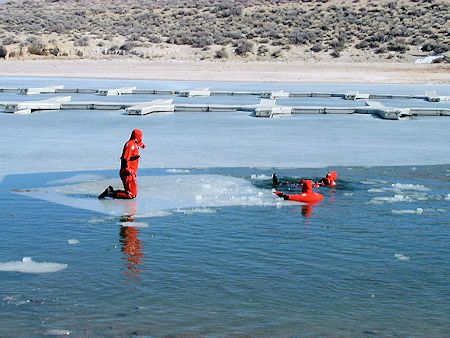
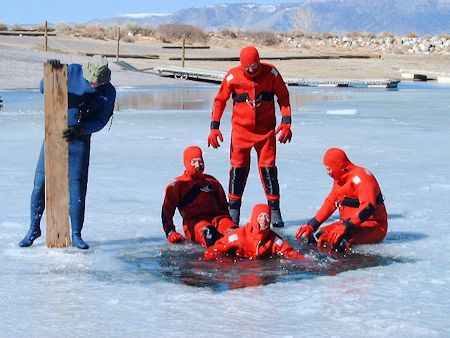
More Lake Ice Rescue Training Pictures
March 17, 2002. 02-03R. Roy Shea was with a group of climbers who were hiking along the San Joaquin ridge. Shea became ill when the group was at 9800 feet on Deadman Pass. He became dehydrated from vomiting and was hypothermic. The others feared he was suffering from altitude sickness. They stopped to warm him with hot water bottles and sleeping bags. They called for help on a cell phone.
Eleven SAR team members responded. Two snowmobiles were used to access the victim on the ridge. Two other snowmobiles and a special rescue sled were staged but not used. The victim and Reporting Party (RP) were transported to the resort where medics treated the victim and transported him to the hospital. Responders were: Enright (ops), Enyeart, Knoche, Rudolph, Morrow, Zahn, Kennedy, Byrne, Greene, Frees, and DeGeorge.
April
Soibian and Miss Aero Spring Huntsman were brief visitors at our April meeting. Shaun Maurer from Ohio visited with possible interest in joining.
Congratulations to Sallee Burns and SLIDER, who passed their Avalanche Certification in a difficult test at Mt. Rose.
The Team has approved a change in the Policy document whereby all members must have up to date training in First Aid and CPR prior to going in the field on an operation. June 15 has been set as the effective date for this year. If you are not current in this requirement, note from the training schedule that you have several opportunities to get it done. Do it.
Many thanks to Kevin McBride, who showed us the proper use of our new full body vacuum splint and extremity kit.
April 24, 2002 - Recruiting Open House
Laura Mogg wrote a piece for Mammoth Times. Committee chair Dori Leyen, has scheduled the public presentation meeting for Wednesday April 24 at fire station #1 at 7 PM. Please plan to be there in your red shirt to help welcome the new people. Click Here For Recruitment Packet (PDF)
We will also need help from some of the rescue members to interview prospective candidates. We plan to vote on the new class of candidates at the May 8 team meeting, so a lot has to happen between now and then.
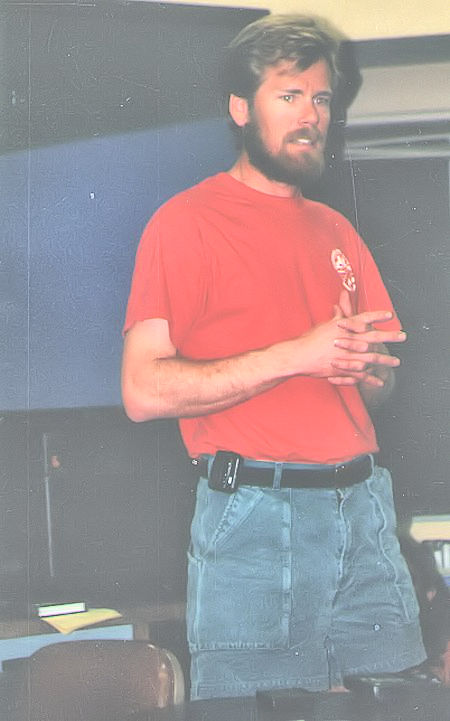
President Greg Enright at SAR Recruitment open house
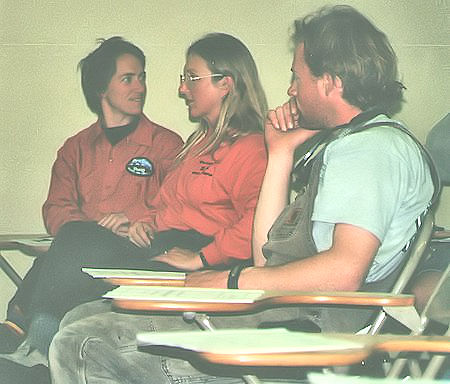
SAR Recruitment open house
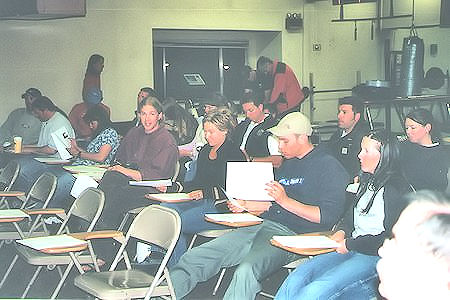
SAR Recruitment open house
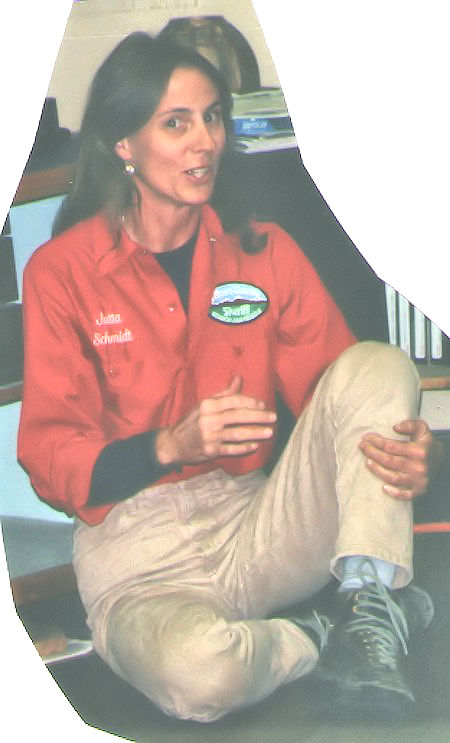
Secretary Jutta Schmidt at SAR Recruitment open house
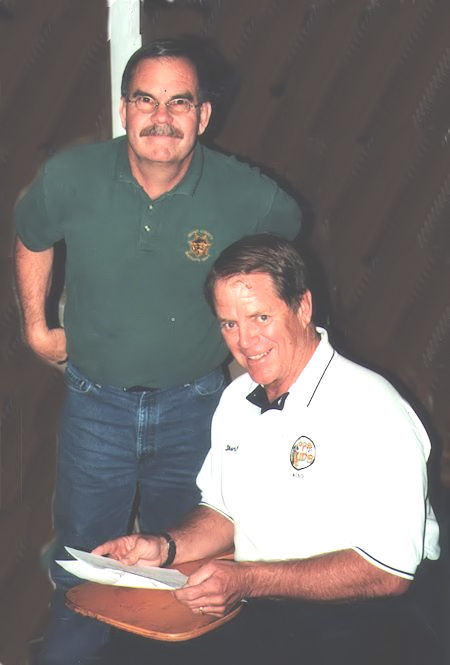
Lt. Boe Turner and Sheriff at SAR Recruitment open house
May
May 11, 2002 - Basic Candidate Class
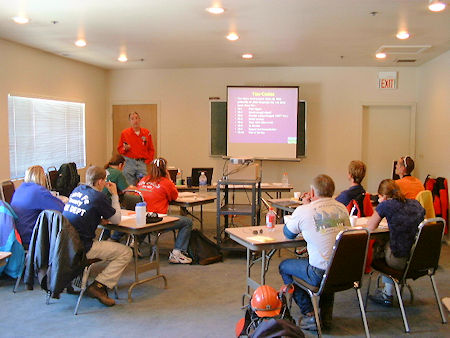
Jim Gilbreath with the new candidates - May 11, 2002
A warm welcome to the seven members of the 2002 Candidate Member Class.
- Nathan Bomer
- Sheilah Knoche
- Troy Kelly
- Jennifer Reynolds
- Todd Bradshaw
- Elise Howell
- James Wright
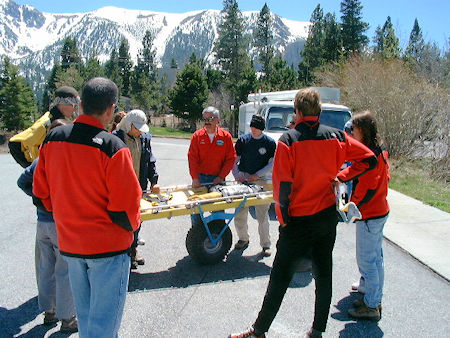
Bill Greene demonstrates wheeled litter handling to new candidates
May 11, 2002
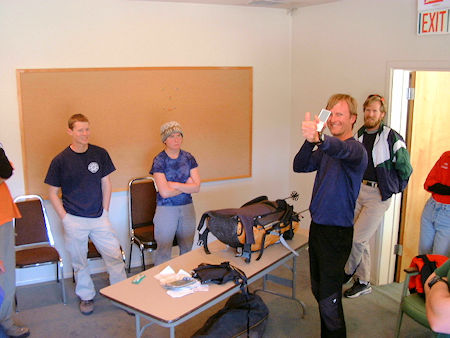
Jeff Holmquist shows new candidates how to signal with a mirror
- what's in a SAR pack demo May 11, 2002
Big ATTABOY to Tim Rudolph, who has finished the welding work on the new litter wheel for our lightweight litter, and showed it at the May meeting.
May 13, 2002 - Tracking Training with Greg Enright
May 16, 2002 - Tracking Training with Greg Enright
Tracking Training - May 13, 2002
Tracking Training - May 16, 2002
May 18, 2002 - Mountain Navigation, Map & Compass, Orienteering Training with Jim Gilbreath
May 20, 2002 - Search Training with Greg Enright at Sherwin Creek Campground
May 29-30, 2002. 02-04R. James Jenkins from La Crescenta failed to return on schedule from a fishing day near Agnew Lake. Three ground teams and two dog teams searched through the night and next day, with assistance from NAS Fallon helicopter.
The victim was found deceased at 1310 on May 30 near the base of Rush Creek Falls by volunteer Dean Rosnau. Recovery over difficult terrain was accomplished without incident – June Lake Fire assisted with the carryout. Responders were: DeGeorge (ops), Aguirre (ops) Greene, Enright, Burns, Hronesh, Riggs, Holmquist, Schmidt, Zahn, and McClintock.
A James Jenkins Memorial Bench was place at the Silver Lake general store in August 2015.
May 31-June 1, 2002. 02-05R. Larry Sedillo from Fullerton became separated from the other three of his group of backpackers in the Silver Lake area. Teams searched the three trails leaving the trailhead area during the night. Teams continued searching the next day, with air assistance from Fallon Rescue 2. The subject hiked out on his own at 1057, having spent the night somewhere near Alger Creek. Responders were: Greene (ops), Enright, Rudolph, Holmquist, Schmidt, Case, Huntsman, Zahn, VanSickle, Knoche, Hronesh, Burns, White, Riggs, and McClintock.
June
Candidate of the Year John Hronesh has completed all his Candidate ladder requirements, and was accepted as our newest Rescue Member at the June meeting. A job well done, John.
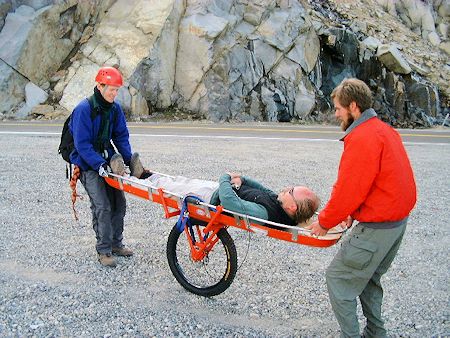
Greg and Nathan try out the new custom litter wheel with handbrake
Tim Rudolph has finished all the work on the new wheel for our lightweight litter, and it IS IN SERVICE, ready to go.
Don Deck, the Webmaster for our superb web site, was unanimously elected to Support Member status at the June Meeting. Keep watching our web site. It just keeps getting better and better!
Thanks to Kevin McBride for teaching the CPR courses for the team. Excellent job!
Tim Rudolph is participating in a 3-day training event with Yosemite Search and Rescue at Tuolumne Meadows.
Bill Greene's good work with Powerpoint and digital video resulted in an outstanding helicopter training at the June Meeting. Our new 60 inch projection screen gave bright and sharp pictures from our video projector.
Troy Kelly and Nathan Bomer volunteered to inventory, replenish, and organize all our maps. Big job, and really important.
It's the end of an era. After 20 years, Bob Sollima is no longer living at Reds Meadows. Our winter workload down there will no doubt increase dramatically since he won't be there to intercept and help the dozens of lost, cold, and confused people he and his dogs encounter each year. Perhaps we will see more of him in town now. Great job, Bob. What's your next act?
Our search dog handlers would welcome Candidate Members and others to observe their training and learn how best to work with a dog team. Call Sallee Burns, Karen Riggs, Noreen McClintock, or Dan Burnham if you can find some time for this fun.
June 3, 2002 - Rock Climbing Rescue Training
Low Angle Rigging with Greg Enright. Tioga Pass Road, near ice climbing area.
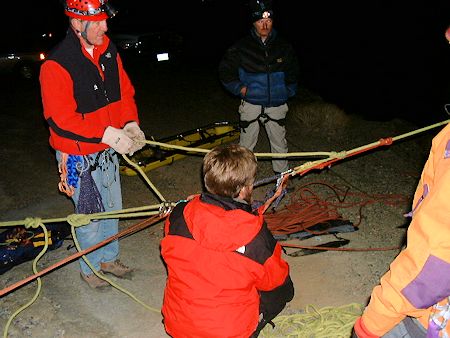
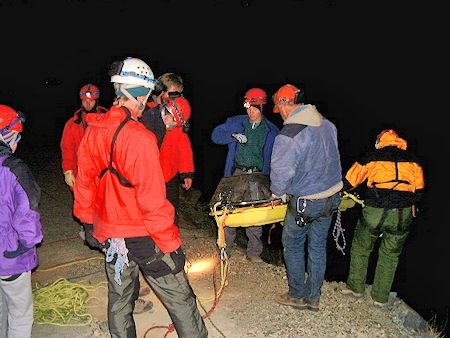
More Rock Climbing Rescue Training Pictures
June 10, 2002 - Rigging For Rock Rescue Training with Greg Enright
Food for Thought: From the Tacoma, WA, News-Tribune: by Jon Jarvis the Superintendent of Mt. Rainier National Park.
June 11, 2002
The most recent tragedies on Mount Rainier and Mount Hood remind us that climbing season is here and with it comes risk. Also come questions such as, "How could this have been prevented?" "Who let those people climb to their deaths." "Why should the taxpayer foot the bill for the rescue?"
As the superintendent of Mount Rainier National Park, I respond to these questions each time we activate our highly trained teams to either rescue or recover those who get into trouble on this great mountain. These good questions deserve thoughtful answers. First, let me speak to prevention. We expend a great deal of effort in educating prospective climbers about the inherent risks of mountaineering. We talk with them during their permit registration, we gain some understanding of their experience, their plans and their chosen route. We inform them of specific risks of the route, of current snow and weather conditions, of proper equipment and the skills they need.
If we sense they may be attempting a route well beyond their skill, we will recommend a different route. If they are true novices, then we steer them to one of our concessionaire-guided trips or training days with groups such as the Mountaineers. But ultimately, it is their decision, and we will not deny them the right to climb, for the mountain is public land and we believe our responsibility is to educate them about the risk but not deny access.
The second part of the question often posed is something like, "If the mountain is so risky, why don't you just close it, particularly during big storms?" As a 14,410-foot glaciated peak, Mount Rainier is always dangerous regardless of the weather. Mount Rainier even creates its own weather. If we did "close it" (which would be practically impossible) for some set of safety considerations, under what circumstances would we reopen it, since it is always dangerous? By the act of "reopening" the mountain that has been closed, we would be implying to the public that it is now "safe" to climb.
The last question, and perhaps the most frequently asked is, "Why should taxpayers foot the bill for rescuing those people who, by choice, subject themselves to a known risk?" The first part of the answer is to examine for whom we, as public land managers, spend most of the taxpayers' money searching. Statistically, on a national scale, and even here at Mount Rainier, we spend more money searching for the lost hiker in the forest or the child who walks away from a drive-in campground, than we do for the mountaineer.
The most expensive search in Mount Rainier's recent history was for Joe Wood Jr., the writer who disappeared in the lower forests of the park in 1999 (and was not found). The risk mountaineers face is often one they have calculated, trained for, experienced in the past and have brought along a lot of equipment to specifically help them survive. A visitor who heads off into the forest without even a jacket, food, water or any of the other 10 essentials is actually taking on a higher risk than that faced by the mountaineer. Poorly equipped to survive a dramatic change in weather, subject to hypothermia, this hiker is also facing a risk by choice. We cannot single out any one group, such as the climbers, and say that they should pay for their rescue and not apply the standard to everyone who is lost.
The second part of the answer is that, as the responsible officials for initiating the rescue and also for making the very tough decision to stop a search before a person has been found, we do not want ability to pay to be a factor in those decisions. Nor do we want ability to pay to be a factor in the visitor's decision to ask for our teams to rescue them. Imagine the scenario of a visitor in the forest, out of food, cold, wet and lost, with a cell phone, worried that they may be facing a bill for tens of thousands of dollars, reluctant to call for help, waiting perhaps until it is too late. Imagine, too, the climbers in trouble, worried about the bill for a rescue, waiting until their physical condition and the weather get horrendous to call for help, forcing our teams to respond in the worst-possible situation.
We use many factors to both launch and to suspend a search, and they are all about risk, probability of survival, probability of success, our teams' capabilities and fatigue and the capabilities of our cooperators like the military helicopters. But not cost. To put cost into the formula would require that our teams search harder and longer for those who have the money than those who do not. Mount Rainier is a great equalizer; the risks are shared by everyone, regardless of their financial status. Mount Rainier National Park is a gift to us all, set aside for our preservation and enjoyment more than 100 years ago, still wild today, offering a range of risks for each of us to experience. It is your responsibility to learn about those risks, whether they come from a day hike to Comet Falls or an independent summit bid, and it is our responsibility to help you learn how to experience the park with an appreciation of those risks.
But should you get in trouble, whether by your own fault or the tricks of nature, one of the finest rescue teams in North America will be gearing up. And we won't be asking for your credit card number.
June 12, 2002 - Helicopter Training after Team meeting
June 17, 2002 - Rigging for Rock Rescue Training
June 19, 2002 - Helicopter Classroom Training with Bill Greene at Fire Station #2
June 23, 2002 - Helicopter Training with CHP at Fire station #1 Wear boots and have goggles or wraparound shades. Helmet if you have one.
June 24, 2002 - Rigging for Rock Rescue Training
June 28, 2002. 02-06R. Mary Ann Smith from Los Angeles sustained injuries from a fall near Minaret Falls. The Team and County Medics assisted the NPS and USFS in the rescue, and she was evacuated by wheeled litter. Responders were: Enright (ops), Aguirre (ops), Case, Greene, DeGeorge, McClintock, Knoche, Holmquist, Schmidt, Wright, and Bridger.
June 29, 2002 - Helicopter Training with Fallon Naval Air Station at Mammoth Airport Wear boots and have goggles or wraparound shades. Helmet if you have one.
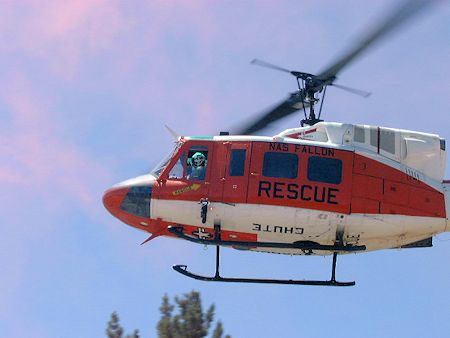
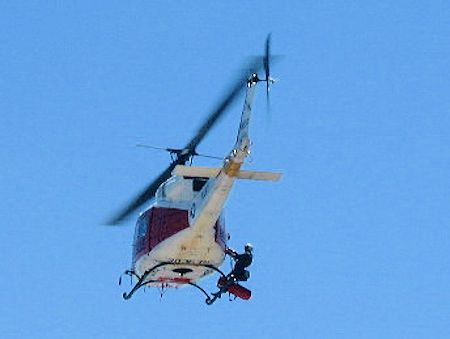
More Helicopter Training Pictures
July
Patrick Byrne has completed all his Candidate ladder requirements, and was accepted as our newest Rescue Member at the July meeting. Let the hazing begin.
July 4, 2002 - Fourth Of July Parade - Dori Leyen did a great job yet again in organizing our entry into the Independence Day parade. Thanks to those who participated. The pictures look great. Patrick - you're awesome.
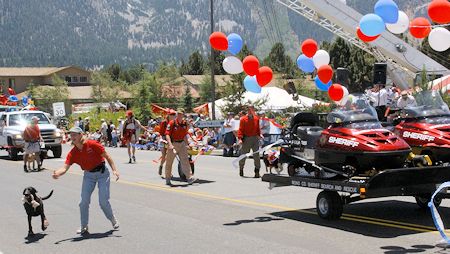
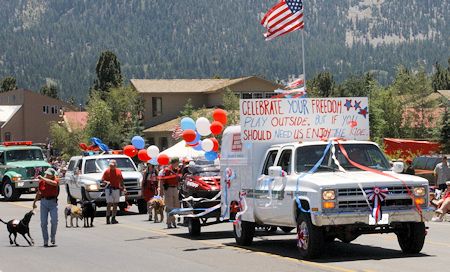
Lori Ciccarelli has volunteered to help the team with publicity, community awareness, and fund raising. She's a real expert at this, and we're NOT. We are very grateful to have her expertise.
Troy Kelly and Nathan Bomer are making very good progress on their project to inventory, replenish, and organize all our maps. Big job, and really important.
Secretary Dadre Albaugh is working on building a flexible and complete computer database for the Team using Access. Big job, and really needed.
Following the Larry Sedillo search, we received a very nice letter from John Grisafe, the Reporting Party (RP). Here are some excerpts from it.
On May 31, 2002, I called the Mono County Sheriff to request a search for my friend, who had been separated from my backpack group for over 6 hours. Within twenty minutes a Deputy, Paramedics, and Search and Rescue Team members were on the scene. Within two hours, data was gathered, a command structure established, a communication system setup, a search plan developed, and at least five search teams deployed. I was so impressed! Fortunately, my friend came out unharmed, and the system setup by the SAR Team reunited him with the rest of my backpack group quickly.
During the twenty hour ordeal the SAR team demonstrated professionalism, skill, compassion, creativity, and determination. The team's esprit de corps and unstated positive attitude set me at ease. I cannot fully express my appreciation for the SAR Team members' sacrifice and determination. I know I speak for my friends, and myself, when I say we have nothing but the highest praise and admiration for all of the members of the Mono County Sheriff Search and Rescue Team. None of the team sought praise, though they certainly deserve it. They went about their task, regardless of risk, focused on finding and helping my friend. I am extremely grateful.
I know all of the people are volunteers, which is truly impressive, and which is hard to believe since everyone has such extensive skill. This extensive expertise is further evidence of the dedication that everyone has toward this cause. The team members not only sacrifice their time for the searches, but also dedicate themselves to prepare and train, so they are truly ready for service.
I have enclosed a donation for the SAR Team. I hope that this money will be useful for training, supplies, equipment, or whatever the team may need. Everyone on the team is a true unselfish hero in my eyes. Please accept my donation, and do take care of yourselves.
We received a very generous donation from the Jenkins family.
Dadre's arduous work on the application paid off, and we are now an Associate Member of the Mountain Rescue Association (MRA).
July 7, 2002. 02-07R. Janice Polochko from Truckee fractured her left fibula while crossing a slope on slippery rocks near Peeler Lake. The Team responded along with Toiyabe Forest Service helicopter 2SA which was able to land near the lake and transported her to Bryant Field. The Team took her to Bridgeport Hospital for treatment. Responders were: Greene (ops), Holmquist, Schmidt, Knoche, Hronesh, Byrne, and Wright.
July 8, 2002. 02-08R. Terry Strandberg from Woodenville, WA developed some symptoms of heart problems while backpacking at Garnet Lake. The Team was called to evacuate the subject. Helicopter 525 was able to land nearby and transported him to the Mammoth Forest Service helipad, where Medic 3 took charge of his care enroute to the hospital. Responders were: Greene (ops), Aguirre, Hronesh, Byrne, Rudolph, McClintock, Kennedy, Kelly, Gilbreath, Wright, and De George.
July 10, 2002 - Radio Training after meeting
July 21, 2002. 02-09R. Dixie Terry From Huntington Beach injured her left ankle while hiking between the first and second creek crossings on the McGee Creek trail. When the team got to the roadhead she had managed to walk out with assistance from the rest of her party. She declined medical help until returning home. Responders were: Enright, Byrne, Schmidt, Holmquist, Rudolph, and Gilbreath.
July 28, 2002. 02-10R. Rick Rivas from Hollister, CA became dehydrated with symptoms of respiratory edema and weakness. The next day he got worse, and his cousin hiked out for help, while his father stayed with him. Their camp was at the west end of Garnet Lake. The group had been in the backcountry six days, and had climbed Banner Peak the previous day. The subject had no medical history, no medications, and had no previous backpacking experience at altitude.
Sgt. Turner requested CHP helicopter H40 from Fresno. The team staged at Minaret Vista. When enough team members assembled to begin a carryout, H40 was only 10 minutes from arriving on scene at Garnet Lake. No teams were sent into the field. H40 landed nearby and was able to take the subject to the Forest Service Helibase in Mammoth. Medic 3 transported him to the hospital for treatment. Diagnosis was basically AMS (altitude sickness). He was released that night. Responders were: Greene (Ops), Gilbreath, Hronesh, Case, Enright, Knocke, Kelly, Howell, Foeller, and Reynolds.
August
Lori Ciccarelli has really been moving with the new print and radio campaign for team publicity, community awareness, and fund raising.
Thanks to Sgt. Boe Turner and Lt. Cole Hampton for hosting our August meeting in the EOC at Bridgeport. The food was tasty and abundant, and the tour of the dispatch center and jail gave us a better understanding of what happens and how busy things can be in dispatch.
Rescue 1 has the new utility bed installed, and is set up as a general rescue vehicle, similar to Rescue 3, but a bit smaller. Rescue 2 is now set up for water related rescues.
Following the Terry Strandberg rescue (July 8), we received a very nice letter from him and another from his brother Michael. Here are some excerpts:
On 8 July, the Mono Country Search and Rescue Team took me by helicopter from Garnet Lake, in the Ansel Adams Wilderness Area, to the Mammoth Hospital, after I incurred dehydration and what proved to be a heart attack. I am now home, have a local cardiologist, and the prognosis is good.
On July 8th your Search and Rescue Team assembled to make an emergency evacuation of my brother, Terry Strandberg. A helicopter was able to land near him and bring him to Mammoth Lakes where he was taken to the hospital without your team having to hike in to rescue him. However, your volunteers took a tremendous burden from me, knowing that they were assembled and ready to go in if needed. Although the symptoms were not definite at the time, it turned out that Terry had indeed suffered a heart attack so the rapid response of the SAR and the Forest Service were critical to his recovery. Please convey my sincere thanks to the members of the SAR team. Also enclosed is a check for the support of your wonderful volunteer organization.
August 3, 2002 02-11R. Neil Looker was reported overdue when he failed to meet up with his group after climbing Matterhorn Peak. He had left the group to climb a more direct route while the group took the longer but easier route, but they failed to reach the summit and returned to Mono Village. The team responded for a search to Twin Lakes, but Looker returned before teams were sent out. Responders were: DeGeorge (Ops), Byrne, Schmidt-Gengenbach, Holmquist, Wright, and Greene.
August 19, 2002 02-12R. Mary Menconi was backpacking with friends in the Green Lake area near Bridgeport when she became surprised by the sight of a bear. She stumbled backwards over a rock, injuring her knee. The next day a friend hiked out to seek help as Mary was unable to walk on the swollen knee. She was carried out using the Team’s new wheeled litter and vacuum splint. Responders were: DeGeorge (ops), Greene, Byrne, Hronesh, and Rudolph.
August 25, 2002. 02-13R. Brandon Lucero from Camarillo and friends were jumping off of rocks into the water at Crystal Lake. According to the Reporting Party (RP), Lucero jumped from 80 feet above the water and landed on his side. He did not impact the bottom or the rocks but complained of injuries to his back and tailbone. The other subjects brought him to shore while the RP called EMS.
Mammoth Fire units and paramedics responded to the scene with wheeled litter. SAR was called out and 10 Search and Rescue members responded and assisted the Paramedics and Fire Department. SAR members also utilized ELT direction finders in an effort to find a signal from a possible downed aircraft thought to have crashed in the area during the time of this rescue. Due to lack of an ELT signal or sign of the aircraft, the search was terminated. Two helicopters also searched the area but were UTL. Responders were: Greene, DeGeorge, Hronesh, Byrne, Knoche, Rousek, Reynolds, and Huntsman.
September
Following the retirement of Terry Padilla, there have been a number of changes in the Mono County Sheriff organization. Cole Hampton is now the Assistant Sheriff (8A2), Boe Turner moves into the Lieutenant ranks as 8L2, and Robert Weber (8S4) is our new SAR Coordinator. Robert has been with the Department 5 years, has BA and MA degrees from USC, and knows the Bridgeport backcountry pretty well. With his new responsibility he will surely want to see the rest of the county's remote parts. Just walking the county borders should be a good start.
Lori Ciccarelli's good work with the print and radio campaign for team publicity, community awareness, and fund raising is bearing fruit. Several donations have been received so far. Gary & Barbi McCoy sent $250 in response to Lori's fundraising, George & Janet McCauley sent $100 with the Mammoth Times ad wrapped around the check, Mary Menconi (Green Lake knee injury) sent $250 and a nice note, Lori's dentist (Craig Schrager, ex-team member) sent $25, and Larry Schwartz, a high school friend of Pete Schoerner's, sent $50 in his memory.
Thanks to The Flower Barn, who sent the Team a basket of flowers in memory of the 9-11 disaster. We raffled it off and made 8 bucks.
Our Bi-Coastal Vice President Paul Zahn is back, after a busy summer moving from Pennsylvania to a house on Chesapeake Bay in Matthews, Virginia. Ummm - where do you really live, Paul?
Thanks to Lt. Boe Turner and Assistant Sheriff Cole Hampton for hosting the recent Team barbecue at Mono County Park. What a feast!! They brought all the equipment and food, cooked the steaks, chicken and sausages. Good thing we didn't have a callout that evening - we were too full of good stuff to move very fast.
The application from Support Member and Webmaster Don Deck reveals his mountaineering stats. In 41 years from 1956 to 1996 he backpacked 11,836 miles, and climbed 169 peaks. Think maybe he knows the Sierra pretty well?
The Team's new Dell Latitude C840 computer has been received, loaded with the usual software, and networked with the other one.
September 1, 2002. 02-14R Jacqueline Keepers from Bishop fell 60 feet while climbing Laurel Mountain. She struck two ledges during the unprotected fall in steep terrain. She was wearing a helmet. She had pain in her left leg, but continued the climb. On the descent she suffered from pain and dehydration and a feeling she might pass out.
The Reporting Party (RP) went for help while the group continued the descent to Convict Lake. Two hasty teams hiked up the Convict Lake trail with medical supplies, and located the victim walking out with the climbing party. Following medical evaluation, they escorted the victim to the trailhead, where she sought medical treatment on her own. Responders were: Rudolph, Schmidt, Holmquist, Enright, Leyen, Greene, Enyeart, Byrne, Knoche, Hronesh, Kelly, Foeller, and DeGeorge.
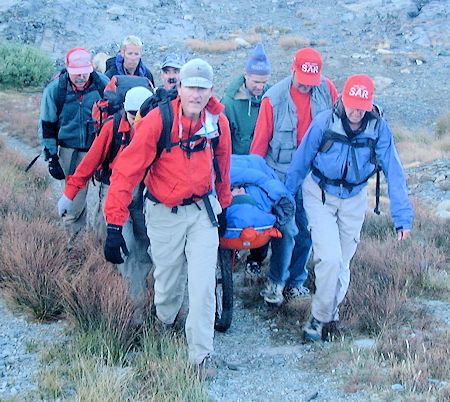
Wheeled litter transport of Herman Hommesom
September 7, 2002. 02-15R. Herman Hommersom from Temple City, CA was hiking next to Shamrock Lake when he stepped on uneven ground and over-rotated his ankle. The Team responded with the wheeled litter, and transported him to the dock at Saddlebag Lake (two mile carryout). He refused paramedic treatment, and friends transported him to Mammoth hospital. Teams were transported across the lake via Saddlebag Resort boat and 821-jet patrol boat (whee!). Responders were: Greene (Ops), Holmquist, Schmidt, Enright, Byrne, Bridger, Leyen, Knoche, Rousek, and Bradshaw.
September 11, 2002. During the team meeting 8S4 advised the Sheriff's Office had a report of a dog barking excitedly near Sotcher Lake. Since it could be an indication of a human in trouble, the team was requested to check it out. Jutta's report - Upon arrival at Sotcher Lake there was no barking dog, so we headed south down the road by vehicle (Burnham) and on foot (Holmquist & Byrne) towards the campground.
Meanwhile I heard some barking to the north of the lake, so we repeated the above scenario up the road towards Devils Postpile campground. The barking was never heard again. Holmquist, Byrne, & Burnham took a stroll along the trail partway around the lake (the northeast quadrant), trying to elicit a response by whistling and howling. Burnham had even tried to get Rozzo riled up and barking, in case the mystery dog would respond to dog sounds over human ones, but to no avail. Responders were: Holmquist, Schmidt, Byrne, and Burnham.
September 12-13, 2002. 02-16R. Phil Rutland (51) from County Wiltshire (England) was part of a military/civilian group from the UK attempting to hike the Muir Trail in 14 days. A party member hiked out and reported that Phil had suffered a seizure, was complaining of chest pains, and was "not himself". The victim was 5.1 miles in, on the JMT a little SE of the junction with the Duck Lake trail.
Holmquist & Knoche went in as a hasty medical team with oxygen to assess the situation. Schmidt, Zahn, Leyen, and Nelson were team 2, carrying the break-apart litter and wheel on their backs. Craig & Jeff put the victim on oxygen. A helo was requested for daybreak.
At 0500 packaging and transport to the LZ began. H20 helo from Auburn arrived at 0900. Subject was taken to the Forest Service Helipad for transport via Medic 3 to SME, where he was examined and released with an AMS diagnosis. Responders were: Greene (Ops), Holmquist, Schmidt, Zahn, Knoche, Wright, Nelson, DeGeorge, Bridger, Enyeart, Leyen, and VanSickle.
September 14, 2002. 02-17R. Vivian Prewit from Tennessee injured her leg while hiking near Iceberg Lake in Madera County. A hiking companion climbed to the top of a ridge to call for assistance with a cell phone. The CHP H40 helicopter, based in Fresno, was called to airlift Prewit out of the backcountry. While Mono County Sheriff Search and Rescue Team monitored the operation, the helicopter crew landed near the lake and hiked to Prewit's location, splinted her leg, and carried her to the helicopter with the help of several nearby hikers. Prewit was airlifted to the Forest Service helipad in Mammoth, and Medic 3 transported her to Mammoth Hospital. Responders were: Enright (Ops).
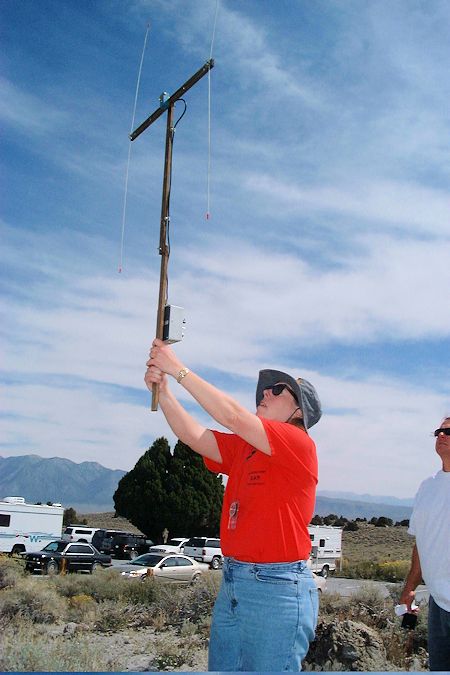
Emergency Locator Beacon Training
September 15, 2002 - Emergency Locator Beacon (ELT) Training.
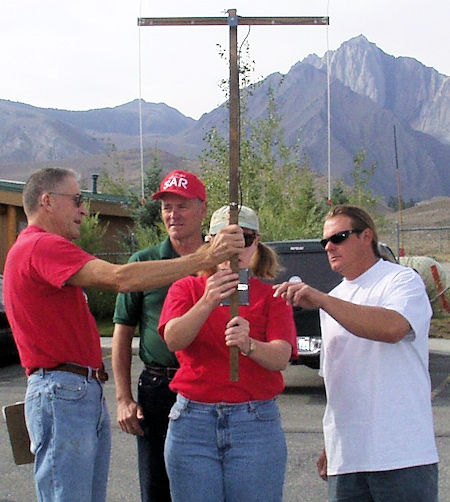
Emergency Locator Beacon Training
Training Scenario: A Cessna 172 private plane in route to Bishop Airport from Gardnerville has been reported overdue, and the US government's satellite based detection system has reported ELT signals in Mono County near Casa Diablo, Convict Lake, and Crowley Lake. The air crash pre-plan calls for taking ELT signal compass bearings from several locations to shrink the search area before committing helicopter and ground forces. This was the emergency exercise scenario on September 15th for the Mono County Sheriff Search and Rescue (SAR) volunteer team. A dozen members and candidates gathered at the Mammoth Lakes Yosemite Airport for an ELT & global positioning system (GPS) exercise taught by SAR instructor Jim Gilbreath.
The ELT is a transmitter located in aircraft that sends out a signal to an ELT receiver. It is activated manually or automatically by impact used as an alerting and locating aid for survival purposes. "Today for this exercise, we will use teams with at least one ELT receiver operator and at least one GPS operator," continues Gilbreath. "Teams will be directed to various locations via radio. Assignments will change as information comes in to Search Base and is analyzed. Other directions will be given by radio as the problem solution develops." Gilbreath along with other team members hold workshops like this annually to keep members trained in search and rescue techniques staying current with the latest.
Mono County Search and Rescue is the only group in Mono County that has the ELT receiver equipment. Last summer, the Sheriff's Department received initial reports of a possible downed aircraft three miles west of the airport. The Mammoth Lakes Fire Department and the Mono County Paramedics were dispatched to that area, but no evidence of a crash was found. The SAR team was then dispatched; they were able to receive an ELT signal from the top of Mammoth Mountain. Subsequently, helicopters from other governmental agencies responded to the crash site near Deer Lakes rescuing a very grateful couple.
September 15, 2002 - Annual Rick Mosher grave site cleanup and Team Picnic
The Rick Mosher grave site cleanup will be at 3 PM at the Mono Lake Cemetery (a mile east of the County Park). Rick died in a plane crash in Convict Canyon while on a search.
This will be followed by the annual Team Picnic, hosted by the Sheriff's Department, at Mono Lake County Park. Please bring your family, significant others, etc. The food is always great!
September 21, 2002. 02-18R. The Team was called to search for David McCutcheon, who crashed his paraglider on the west side of White Mountain. The crash of the glider had been witnessed by ground teams associated with the US Paragliding Nationals competition, who saw the glider falling with a reserve parachute deployed.
An ultralight aircraft pilot flew up to spot the crash location between 10,000 and 11,000 ft, but the victim had folded up his glider and reserve chute before the Forest Service helicopter 525 arrived to search for him. The victim was impossible to find in the rugged terrain, and darkness forced the helicopter back to Bishop Airport.
The SAR team requested a night flying helicopter with thermal imaging to search the area, but the victim was able to radio to the competition organizers that he was not injured and would hike out in the morning. Responders were: Enright (Ops), Greene, Albaugh, Rudolph, and Byrne.
September 21-22, 2002. 02-19R. Donald Smith, from Yuba City was dropped off by a friend in the morning for a day of deer hunting, with the intent of being picked up after hiking approximately five or six miles along Rough Creek in the Bodie Hills area.
They had driven the dirt roads in the area the day before, but neither had ever hunted in the area. The hunter carried a compass, but no map. He was well dressed for the evening low temperatures.
After the hunter failed to show up that afternoon, the friend drove dirt roads in the area without being able to locate him. The SAR team was called out, and located the track where he had been dropped off. A tracking team was assigned to follow his footprints.
Another team was assigned to begin searching for track approximately three miles along his intended route. They found his track, and followed it down Rough Creek Canyon towards the Nevada border. The track was lost near the Nevada state border when the subject entered a rock covered area.
Through the night and into morning the team continued searching for track. Forest Service helicopter 2SA was tasked to assist the SAR team. Team members arriving in the morning were assigned to drive a 4WD dirt read to the remote area near where the field teams were operating.
While driving to their assigned position, they found the subject walking along the dirt road. He was only one mile from where the field teams lost his track. He had no injuries. Deputies drove him from Bodie to Bridgeport. Responders were: Greene (Ops), Enright, Byrne, Holmquist, Schmidt, Rudolph, Burns, and Leyen.
September 28, 2002 - Wilderness Finders (WOOF) Train Locally
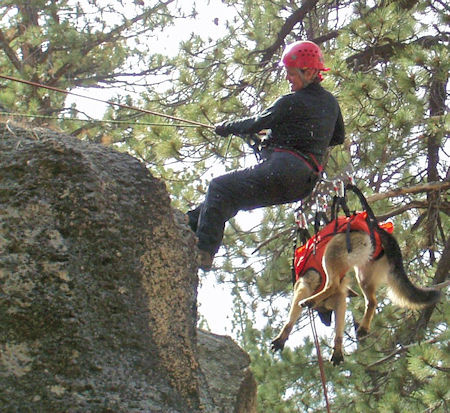
WOOF Dog Training - September 28, 2002
Have you taken your dog for a walk over a cliff lately? On Saturday, September 28th, WOOF teams participated in a rappel training at a rock climbing area near the Crestview Maintenance Station off of Highway 395. Four local dogs and their handlers from Mammoth Lakes and June Lake were part of a group that participated. The dogs wore a special harness that was attached by a carabiner to their handler's harness; the handler then rappelled off the edge of the cliff with their dog.
The Mono County Sheriff Search & Rescue (SAR) team assisted with the training. The Mammoth Lakes certified WOOF team members include Sallee Burns and Slider, and Karen Riggs and Dash. Mammoth Lakes WOOF team candidates include Noreen McClintock and Ursa, and Dan Burnham and Razzo. "It takes about two years to complete the training and become certified," says Noreen McClintock. "Ursa is two-and-a-half years old. I've had her since she was seven-weeks old. The handler and dog live, train and work together for life." WOOF teams are trained, tested and certified yearly in different disciplines of SAR dog work. All WOOF dogs are certified area search dogs and all have expertise in at least one other discipline that may include avalanche search, disaster search, forensic search, water search, evidence search, tracking/trailing and obedience.
Teams carry the equipment necessary, including a radio, to be self-sufficient in the field for three days. Most handlers are qualified as First Responders and some have higher medical training. They are skilled in canine field care, search and rescue procedures, year-round wilderness survival, and backcountry travel.
Wilderness Finders, Inc., has 20 - 30 members/ candidates and is on-call to the entire US with most calls coming from California and Nevada. WOOF is a non-profit, volunteer unit whose primary object is using trained dog teams to find people in trouble and to provide medical aid. Teams meet rigorous qualifying standards. Since the unit started in 1975, WOOF has shown that well-trained search dog teams are an excellent way to find missing people. These experienced handlers with qualified WOOF search dogs are ready 24-hours a day to respond to calls for lost or missing persons.
"These skills are hard to maintain and as volunteers we are asked to train monthly as a group, and also train individually on a weekly basis. Our skills for wilderness search and rescue are the same for disaster search and rescue," says WOOF president, Ben Ho, M.D. "Our training today for rappel and rope work would be used for both wilderness and disaster situations. Exactly one year ago, three of our WOOF teams were involved with the searches that took place at 'Ground Zero' using these types of skills. We were also part of the Oklahoma bombing searches. It is also important that our teams know personal first aid, victim first aid, and veterinarian care because the handlers may be the sole provider regarding care for their dogs on the scene." If you would like more information, visit www.searchdogs.com.
October
Training Officer Jeff Holmquist gives us these reminders about being properly prepared.
Here are a few things that we all can do to make things easier for ourselves, the team, and ultimately the people that we are trying to help.
1. Have a big enough pack. Fanny packs and small day packs have very little use in SAR. If you had to choose one size, 4000 cubic inches would be a good bet. Remember, you may be handed 3000 c.i. of team stuff to haul. And, there's room for lots of cookies in a big pack.
2. Tim's wheel and the two-piece litter potentially allow us to get in to our victim very quickly. However, we can burn a lot of those time savings fiddling with strapping the stuff on to our packs. Take some time and figure out how to attach a litter half or the wheel *before* you are asked to do so on an op. When we got the new litter I made some minor strap modifications to my two packs so that I can attach a litter half in just a minute or two. What I hadn't done was remember to do the same for the wheel. I finally checked it out, and it turns out that my litter set-up works just as well for the wheel. We should each spend a few minutes at Rescue 3 working out the ideal techniques for mating our packs with the litter and wheel- beats doing it for the first time in the cold and dark.
3. Think overkill when packing your gear on an op. I think that too often we take an underkill approach instead; after all, everyone likes light packs. But remember that, unlike a typical dayhike or backpacking trip, you are setting off without knowing exactly what is going to happen. A six hour assignment can turn into a 48 hour assignment with a bivy or two. You are also packing for the subject and your teammates as well as yourself. This goes particularly for food, and also water if you are looking at dry terrain. You may not feel that you need much food and water, but your partner's pack may get blown over a ledge by a helo, or the contents may be devoured by a bear or by Jutta. Within reason, go heavy. After all, we're supposed to be tough outdoorsy folks.
4. We all have a sort of "ready pile" somewhere, in the trunk of the car, by the door, etc. Remember to keep updating the contents of your pile of junk as the weather continues to get colder and wetter. Think in terms of the worst weather that you might face instead of the average conditions. In the first week of this October, after weeks of spectacular weather, Jutta and I went up to Tuolumne for the YOSAR op. We were pretty well prepared, and were glad that we had been thinking in terms of worst possible conditions, because we ended up bivvying in falling snow and 12 degree temps. Still, Jutta would have liked a heavier bag and I would have liked to have had my non-leaky shell. Moral: when you think you've already put too much stuff in your duffel or pile, you are probably still not quite there. When in doubt, throw that extra stuff in with your ready gear. *Note* Any apparent references in the above to persons living or dead is purely coincidental. Jeff
The new hoist has been tested, and was a pleasure to use. Here's some notes from Training Officer Jeff Holmquist that will pique your interest.
Hoist Notes
Advantages:
Disadvantages:
Here's what we have learned about set up and knot passing. You must work with the hoist at a training to get the full picture, but this should give you an idea of what's involved:
Set-up:
To pass knot (Note that passing a knot with the Z-pulley was about as easy as passing a kidney stone; this is much better):
Nathan Bomer and Diane are out of the area for four months, and are off the callout list for that time. They are in Bozeman, MT for a couple days, and then it is to Michigan, Oklahoma, Peru and Ecuador. Hoo-wah!!
Lori Ciccarelli has really been busy with team publicity and community awareness, as well as fund raising. She has had articles on ELT and WOOF training in Mammoth Times, KDAY TV and radio, KIBS radio, and our web site.
Dori Leyen is doing the big job of organizing our annual Team Dinner and awards party, which will be held at the Double Eagle Restaurant in June Lake on Wednesday December 4. You will receive an invitation in the mail (if you've been nice, and not naughty).
Quote without comment. For its training value for us, here's some excerpts from an article in Backpacker magazine regarding the Eric Tucker search that our team helped with more than a year ago.
The 28-year-old computer engineer from Mountain View, CA, had changed plans on day 1 of a 5-day, 50-mile loop through California's 113,000-acre Emigrant Wilderness. After his chosen route from Kennedy Meadows toward Big Sam Mountain kept disappearing in the rocks, Tucker worried that he'd lose it altogether, so he turned down a small creekbed he thought would intersect the main trail up Kennedy Creek.
Tucker's creekbed shortcut dropped sharply, then choked off at a 45-foot, three-tiered cliff. "It looked like the last thing I had to get down before I was in the clear," he recalls. Tucker figured he'd toss his pack down to the first ledge and scout one level at a time. But his pack bounced to the bottom. "At that point, it would have been better to turn around," he reflects. "I'd have been dehydrated walking out with no water or supplies, but my legs would have worked."
Tucker was climbing (down) to his pack when he greased off slick holds and fell 30 feet to the base of the cliff. "I don't know how my shoulder got dislocated," recalls Eric Tucker. "But I landed on my feet. If I'd hit my head, the whole thing could have turned out a lot worse."
Things were bad enough. Tucker lay at the bottom of a narrow ravine with a broken left ankle, a sprained right ankle, torn knee ligaments, and a dislocated right shoulder. He was far from any trail, and search efforts wouldn't even start for a week. For 5 nights he holed up on a rocky ledge, rationing his food and wincing as his shoulder popped and ground toward realignment.
Fortunately, he'd landed next to his pack and a small trickle of water. On the 6th day, Tucker was healed up enough to move toward a more visible location in the valley below. Hanging his pack off his good arm, he clambered 20 feet down the slope before his shoulder went out again. "Now I couldn't even get back up to where I'd started because I couldn't use the arm for balance in the ravine," he recalls. "I got really discouraged because there was no water right there. I was scared I'd die from dehydration."
On the morning of his 7th day, Tucker's shoulder was better, and he made it back up the slope to water. The first helicopter appeared on day 8. "I thought, 'Great! I'll just wave my big yellow poncho and they'll see me.' But they didn't," he explains. Over the next several days, four helicopters flew directly overhead, but none spotted him. That same afternoon, Tucker finally reached the valley floor, but the trail he'd expected had vanished. "That was another bad time," he remembers. "I felt I couldn't trust the map, but now I know I misread it."
Tucker pitched camp and built the first of numerous signal fires. "I should have been working to make more smoke," he says. By now he was 4 days overdue and the target of a massive search effort. More than a hundred ground searchers were combing the Emigrant. "When the 'copters didn't see me, I began to think seriously about getting myself out," says Tucker.
Despite stabbing pain in his ankles, he spent the next 5 days limping from camp on short forays, scouting for possible exit routes back through the cliffs he'd fallen down. Finally, a day after rains pounded the Emigrant, Tucker found a way through talus and rock bands to the ridgetop. There, he located the trail he'd been seeking.
On the way out, Tucker shuffled past 12 or 15 hikers in small groups. "I didn't want to inconvenience them," he reasons. "And by now I was determined to get myself out." It took him 6 hours to reach the busy Kennedy Meadows trailhead, 2 weeks after he'd left it. Search operations had been called off that morning.
Professional Opinion: California State SAR Coordinator Matt Scharper calls Tucker's shortcut "a very typical mistake in rugged wilderness environments. Because it's physically easier, victims often head downhill through steep terrain, then get in trouble at the rollovers. Eric saw those 'copters only because that was the path they followed for refuel. Nobody was looking where he was, relatively close in."
November
Amy Sage and her visiting parents were guests at our October meeting.
Shani Foeller's father also visited.
Lori Ciccarelli is our newest Support Member, having been enthusiastically voted in at our November meeting.
The following five people were elected to two-year teams on our Board of Directors:
Dori Leyen, Jutta Schmidt, Jeff Holmquist, John Hronesh, and Patrick Byrne. Team officers will be selected by the board at their January meeting.
The June Lake team cache at Gull Lake will be moved around a bit as the building is converted to a Sheriff Substation. This will be good for everybody, since we will have access to the space and radios if we need to run an operation from there (instead of the June Mountain parking lot).
Dori Leyen is doing the big job of organizing our annual Team Dinner and awards party, which will be held at the Double Eagle Restaurant in June Lake on Wednesday December 4. You may not get this newsletter prior to the dinner, but you got your invitation.
A solo climber was overdue in the Minarets, but got out OK, just late. Subject was a very experienced climber (summited Everest) who had planned to climb Clyde Minaret. He started out in the AM with the intent of being out by 9 p.m. When he failed to call his wife she informed the Sheriff's Office at 1 a.m. Mammoth Police Department located his car still at the parking lot, and called Bill Greene to start gathering info for a call-out. At the end of a lengthy phone call with the subject’s wife in Sacramento, subject paged his wife stating he was at his vehicle. He had fallen during the climb, and broken his nose and hand, resulting in extreme difficulty in getting off Clyde.
Bill and Greg checked out a reported satellite ELT hit seven miles west of Mammoth airport, but heard nothing.
From a couple of months back - we were asked for Mutual Aid response to Yosemite to help search. Here's Jeff's comments about that.
Howdy folks. Here's what I know: Walter Reinhardt, 62 years old, 5' 8", 125 lbs, left his car at White Wolf for a day hike on about 20 September. He is thought to have been traveling with a fanny pack and no jacket. He did not leave word with anyone about his intentions, although it is thought that he was planning to leave later that day for a trip to Las Vegas and thus would have planned only a short day hike.
The search was begun after rangers became concerned about the unmoved vehicle. I think that Yosemite National Park started searching on Monday 30 Sept, concentrating on the White Wolf area through Tuesday 1 Oct. There was helo searching on Monday, but there was only sporadic helo use on Tuesday due to snow, high winds, and low clouds.
On Wednesday, the weather cleared, and more emphasis was placed on the Ten Lakes area. Several dogs teams were flown in to search the Ten Lakes and Grant Lakes basins, and there were at least two helos searching, although a helo crew member told me that their windspeed cut-off was 40 mph, and that they were right on the edge of that restriction.
There were at least ten ground teams out on Wednesday. Given the subject's lack of equipment, start of the search ten days after he left his car, and the intervening weather (Tioga Pass recorded 12 degrees on Wednesday morning), Yosemite National Park is clearly thinking in terms of body recovery at this point and searching was planned to be scaled back starting on Thursday, with the emphasis perhaps switching back to more detailed searching around the White Wolf area. Search may have been suspended on Friday.
Our members Burns and McClintock responded with their dogs on Tuesday and Wednesday (Thursday too?). Holmquist and Schmidt did a hasty trail search (May Lake trailhead to Ten Lakes to Yosemite Cr trailhead) with a trail corridor search in the Ten Lakes area on Tuesday and Wednesday (bivy).
(Editor's notes - 1) That little hasty search covered well over 20 miles. 2) Wouldn't it have been nice if the victim had left a note in his car?)
November 25, 2002 - Lake Ice Rescue Training at Twin Lakes
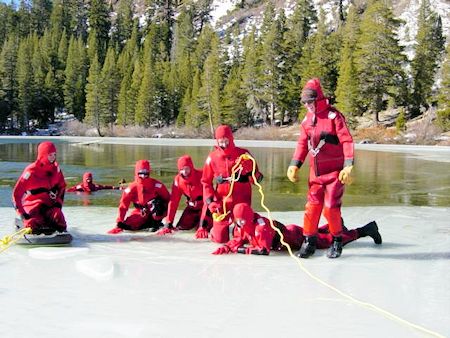
Lake Ice Rescue Training - Twin Lakes - November 25, 2002
December
Dori Leyen did a wonderful job of organizing our annual Team Dinner and Awards Party, which was held at the Double Eagle Restaurant in June Lake on December 4.
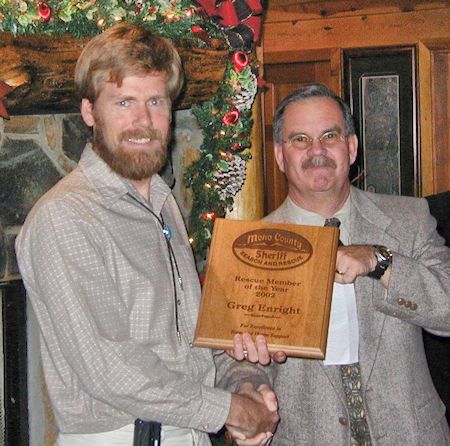
Greg Enright receiving Pete Schoerner Rescue Member of the Year
from Lt. Boe Turner
Each year, the all-volunteer Mono County Sheriff Search and Rescue Team honors members for their individual excellence and public service.
The team's main honor for achievement is the Pete Schoerner Rescue Member of the Year award. The award is named in memory of a beloved teammate who was killed in an ice-climbing accident in 1996.
The Pete Schoerner Rescue Member of the Year is Greg Enright. Enright is the longest-term team member (but far from the oldest).
He has served as Team President repeatedly and has been the sparkplug of the team for many years.
He has participated in more than 300 team events since 1995 and many more before that.
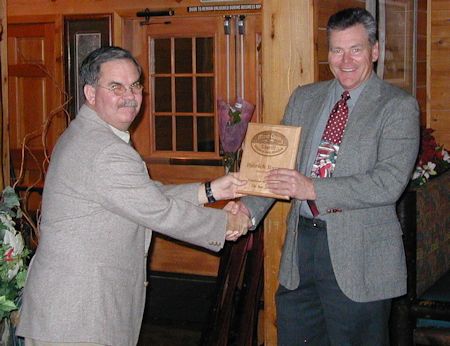
Patrick Byrne receives Candidate of the Year award from Lt. Boe Turner
New members in training are called Candidate Members and must undergo training, practice, and testing in 18 categories of skills before being considered for advancement to Rescue Member.
Examples of these skills include first aid and victim care, tracking, technical rescue, mountain navigation, helicopter operations, and skill with electronic aids such as radios and GPS receivers.
Completion of all requirements requires a lot of dedication and faithfulness over a period of a year or more. The dropout rate is very high.
This year, the team selected Patrick Byrne as the Candidate Member of the Year. Byrne has been very active and faithful in both his training and in rescue operations and has recently advanced to Rescue Member status.
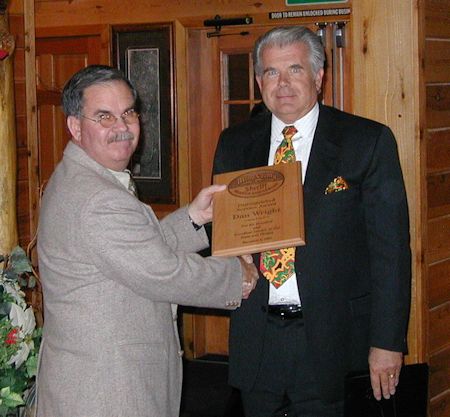
Dan Wright receiving Distinquished Service Award from Lt. Boe Turner
Bob Sollima received a 20-Year Service Award. Bob has spent many winters at Reds Meadow and goes out on cross-country skis with his dogs looking for people in trouble, which happens often when skiers and snowboarders ride outside the ski area and get lost.
Dan Wright received the Distinguished Service Award in recognition of his many years of devotion and excellent service to the team and victims.
Team President Greg Enright and Lt. Boe Turner presented the honorees with laser-engraved cherrywood plaques at the annual team awards on Wednesday, December 4, 2002 at the Eagle's Landing Restaurant, Double Eagle Resort, in June Lake.
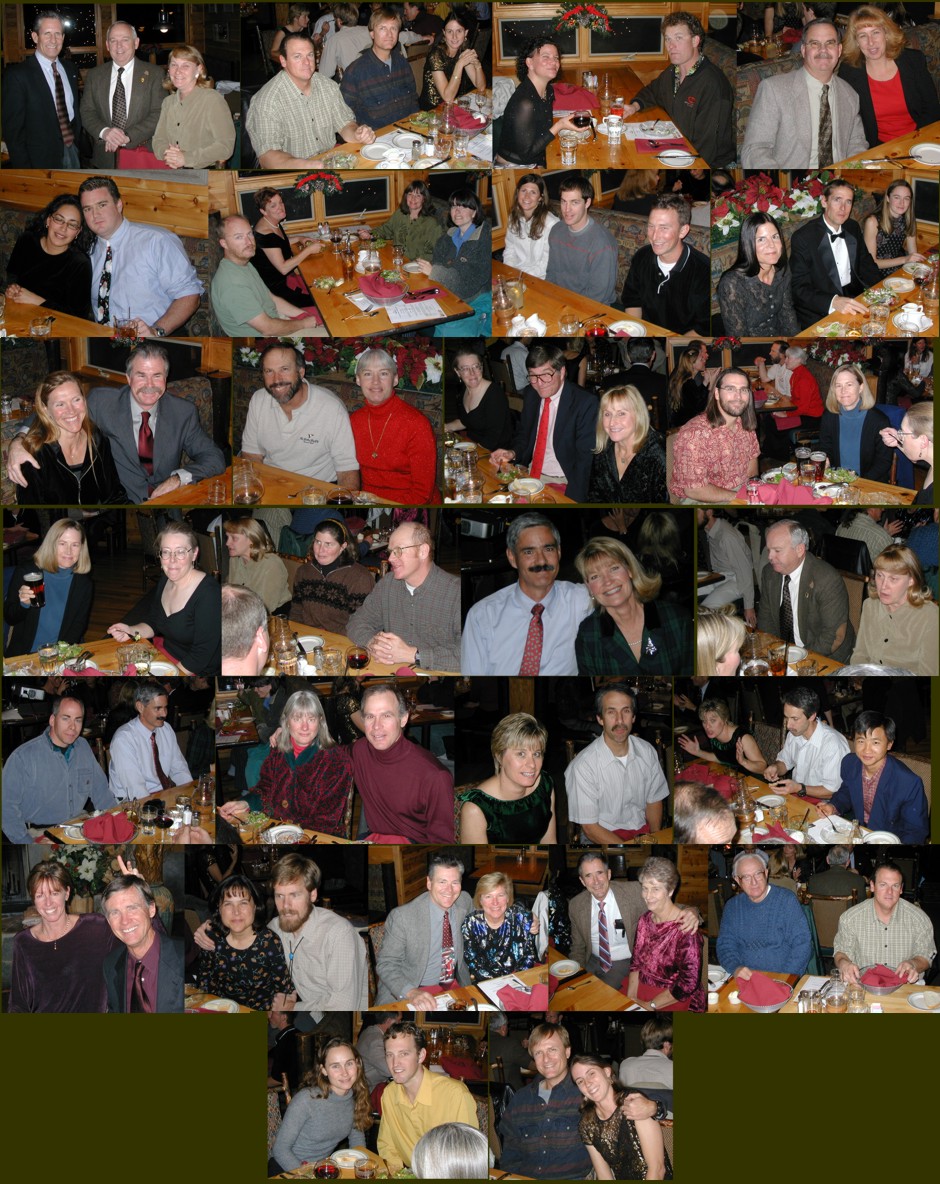
December 11, 2002 - Lake Ice Rescue Classroom Training after meeting
December 29-30, 2002. 02-20R. Gary Standridge and Kelly Kwast from Ramona (San Diego County) left the campground at 1300 to climb ice in Lee Vining Canyon. When they failed to return by 2200, friends contacted the Sheriff's Office.
A team was sent via snowmobile to their last know position to follow tracks. The team was able to follow track to the mouth of the canyon, where track was lost due to blowing snow. After backtracking to re-acquire track the team saw a headlamp down-slope near the Poole power plant. They located the subject there in a pit covered with pine boughs, in good condition. They were transported to base via snowmobiles. Responders were: Greene (Ops), Holmquist, Hronesh, McClintock, Lewis, Zahn, Kennedy, Burns, Bridger, and DeGeorge.